
BY BILL ADAMS
About once a week, a new fire truck pulls onto Commerce Road in Luverne, Minnesota, and heads toward Interstate 90. Its destination could be anyplace in North America.
Unique to the fire apparatus industry is the apparatus is not headed to a local or regional dealership where it might be outfitted and prepped for delivery. It has been sold factory direct to a fire department (or its governing political subdivision). Interestingly, most departments opt to pick their rigs up after final inspection and receiving factory training. Equally intriguing is after the rigs are placed in service, the fire departments receive a personal telephone call from the apparatus manufacturer’s owner thanking them for their business.
The owner’s name is Sarah Atchison, and the manufacturer is Midwest Fire Equipment and Repair Company, also known as Midwest Fire and sometimes just Midwest. Two items are worthy of discussion. The first is the continuing success of what I admiringly call a mom-and-pop fire truck manufacturer. The second is the concept of selling factory direct by choice. Atchison agreed to and gave several in-depth and candid interviews.
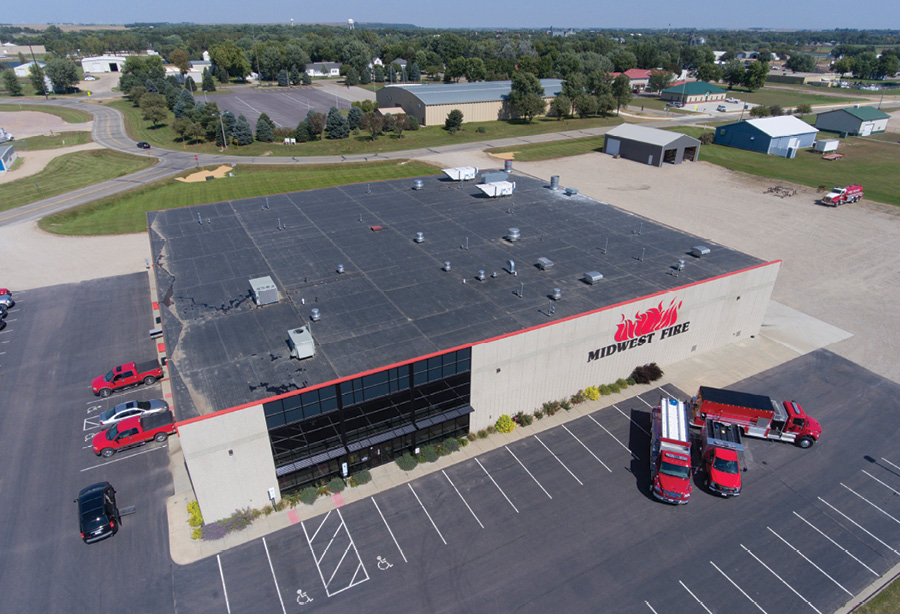
1 Midwest’s factory was designed for future expansion. It currently has more than 33,000 square feet and has been manufacturing just more than 50 rigs per year over the past several years. (Photos courtesy of Midwest Fire Equipment and Repair Company.)
MIDWEST’S LINEAGE
Fire trucks have been built under various monikers in Luverne since 1904. The first company building fire apparatus there was a family-owned business—so is the present one. Brothers Al and Ed Leichner purchased the Luverne Wagon Works in 1896. In 1903, the business was renamed the Luverne Automobile Company. It changed again in 1912 to the Luverne Motor Truck Company. In 1923 it became the Luverne Fire Apparatus Company. Each name change reflected its primary product.
In 1985, the Luverne Truck Equipment Company, a manufacturer of assorted vehicle accessories, purchased Luverne Fire Apparatus. It was moved 20 miles away to Brandon, South Dakota, in 1987. Scott Schneekloth, an employee since the early 1970s, and wife Pam and two coworkers stayed in Luverne and started a business servicing and repairing fire apparatus. They called it the Midwest Fire Equipment and Repair Company. The Schneekloths kept developing their business until retiring in 2013 when Sarah Atchison purchased it.
Luverne Fire Apparatus remained in Brandon. It was purchased by Spartan Motors in 1997, renamed Crimson Fire in 2003, and eventually renamed to Spartan Emergency Response. It is still there—competing daily with Midwest Fire.

2 This interior view shows two tanker-pumpers and a brush truck in various stages of construction. Owner Sarah Atchison says the terminology tanker-pumper is a term Midwest uses in-house. There is no difference between it and a pumper-tanker.
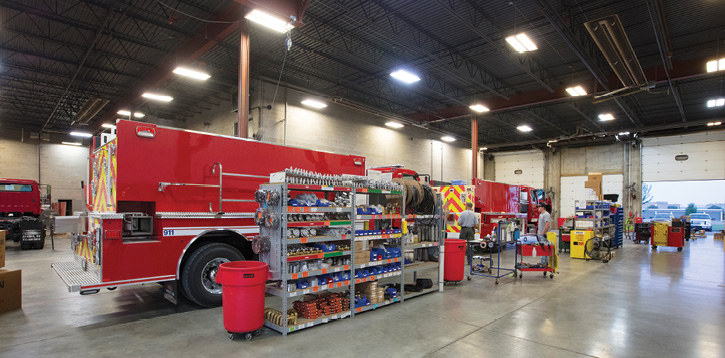
3 Another interior view of a portion of Midwest’s manufacturing area.
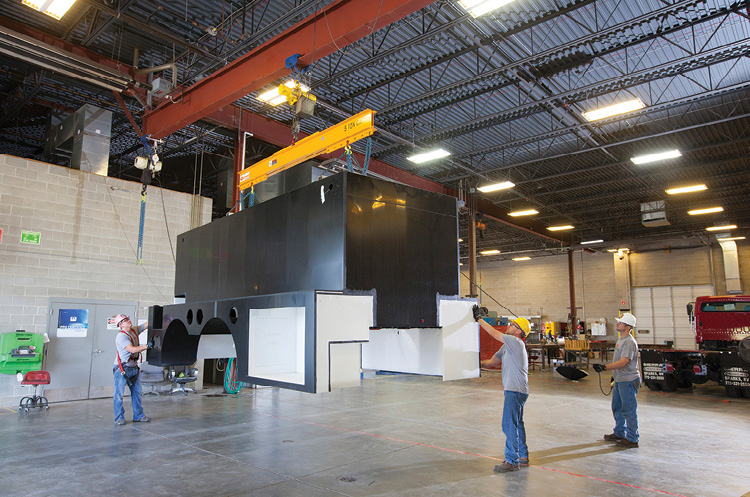
4 Workers are using an overhead crane to move an All-Poly body. More than 99 percent of Midwest’s production is with high-impact-resistant copolymer polypropylene.
FAMILY BUSINESS TRADITION
Many family-owned apparatus manufacturers have either gone out of business or have been sold to larger competitors or holding companies. Sutphen and Darley are two larger well-known exceptions. The Atchisons’ purchase of Midwest follows the Leichner and Schneekloth traditions of a family owning and operating a small but growing fire truck factory.
Midwest Fire Equipment and Repair Company is legally organized as a limited liability company under Minnesota statutes. It is 60 percent owned by Sarah Atchison, a hands-on president and CEO who runs the day-to-day operations. Her parents, Jane and Lyle Gessell, own the remaining 40 percent of the company. According to Atchison, “The Gessells are not active in the business. They are silent investors and excellent business partners.”
Husband Dean, an entrepreneur himself, is not involved in daily operations. Atchison says, “Dean is involved when we need him to be. He assists with and leads much of our lean manufacturing and continuous improvement initiative. He is only on site at the facility several days each month working with our production team with our ‘Kanban’ inventory system, flow, process improvement, quality management system, vendor evaluations, etc.”
THE TRANSITION
Atchison explains, “The Schneekloths were conscientious small business owners. They operated with integrity and a commitment to doing things the best way possible. Midwest had been a growing profitable company that presented an opportunity to take it to the next plateau with new ideas and investment. We could allocate additional resources to mechanical design and the manufacturing processes to meet customers’ growing demands for more sophistication and capabilities in their apparatus.”
When the Schneekloths retired, many of their personnel remained with the company. Atchison says, “Many of the original Midwest employees are still with us, some from the very earliest days of the company. General manager Brett Jensen has been with the company 26 years, starting as a painter, and has worked in every area of the company. Jeff Bowen is a Luverne native and a long-time leader of our sales team. Kraig Scholten is another long-time Midwest Fire employee with a diverse background from sales to purchasing to production manager. He now leads our Project Management department, ensuring a positive experience for each of our customers. Shortly after acquiring the company, we recruited a new accountant to lead the financial side of the company. Darcie Johnson came over from Luverne Fire Equipment in Brandon. She has been a great addition to our team. Over the past six years, we have hired some new sales representatives, a new mechanical engineer, and a few new members for our production team. The team we have in place right now is the best we’ve ever had and has us well-positioned for continued growth.”
FACILITY
Midwest’s factory is located on about five acres in Luverne’s business district. Luverne, a small Minnesota city of about 5,000 residents, is located in the extreme southwest corner of the state. It is closer to South Dakota and Iowa than any similar sized city in Minnesota. The factory encompasses more than 33,000 square feet and was constructed in 2008 specifically for manufacturing fire apparatus. Designed for future expansion, one wall can be moved out by 40 feet to increase the manufacturing floor by 3,200 square feet.
It is a two-story building including showroom, offices, conference space, shipping and receiving area, two state-of-the-art paint booths, a pump testing bay with a 20,000-gallon underground holding tank, project management space, and a large combination employee lunch/training room. An adjacent building provides an additional 2,400 square feet of storage.
Asked about plans to increase the space, Atchison replies, “Not at this time. The lean manufacturing and process improvement work we have done over the past five years has resulted in significant productivity improvement for our company. We currently operate with one shift, so we can also opt to add a second shift when the time is right.”
PRODUCT EVOLUTION
“From the mid 1990s until the new manufacturing facility was completed around 2008, Midwest Fire primarily manufactured tankers,” says Atchison. “The company also built some mini pumpers, quick attacks, and rescue trucks. When we acquired the company in August 2013, it had already started manufacturing more tanker-pumpers and fewer straight tankers. Part of our initial comprehensive strategic roadmap completed after acquisition was to invest deeply in developing a line of high-quality and cost-effective All-Poly tanker-pumper trucks. These 2,000-gallon, 3,000-gallon, and 4,000-gallon tanker-pumpers are the foundation of our product line today.
“During this time frame, we also began designing and manufacturing brush trucks, standardizing our offering on the Ford F-550 chassis (standard or crew cab) with an aluminum body, 300-gallon tank, and a portable pump. They are very competitively priced and it is a growing business segment for us. We have also manufactured them with our All-Poly body.”
Regarding galvanneal steel, stainless steel, and aluminum bodies on tanker-pumpers and pumpers, Atchison says, “Although we do offer these options, 99 percent of what we build is our All-Poly line. During 2017 and 2018, we invested engineering and research in developing our new All-Poly pumper line that we exhibited at FDIC International this year. We believe it meets the needs of a lot of fire departments throughout North America. For far too long, fire departments and communities have been told that they need to spend $500,000 or more in order to buy a new pumper. That is simply not true. If people do their research with an open-minded comparison, we think they will really like what our new line offers. There is a lot of interest in it, and we have a number of projects in the pipeline.”
According to Atchison, an All-Poly body is a trademark registered to Midwest Fire that is central to the expertise that it has in working with high-impact-resistant copolymer polypropylene. “We are proud of our expertise in this area,” she says. “I believe Midwest Fire was one of the pioneers in the use of polypropylene in fire truck manufacturing. It is an incredible material. Its functionality and durability have been proven by firefighters using it in the field over the last decade.” She adds that the 3,000- and 2,000-gallon tanker-pumpers followed by brush trucks, quick attacks, and the new pumper line are Midwest’s most popular products. “We also offer rescue and wildland apparatus,” she adds.
Atchison states that the majority of its All-Poly bodies have historically been manufactured by APR Plastic Fabricating, Inc., and this is still currently the case. “Midwest Fire and APR have an excellent working relationship and a long history of collaboration on the [polypropylene] tanks and bodies for use in the fire truck industry,” she says. “However, we are open to working with all [polypropylene] manufacturers that can build to our All-Poly specifications.” Atchison continues, “Our truck body design is shared with the body manufacturer, and we work together to approve the final engineering design together. In the end, the body manufacturer has final say because they provide the warranty on the tank/body.”
FACTORY DIRECT
I believe there are two basic reasons manufacturers sell factory direct. The first is when established manufacturers cannot retain qualified dealers or cannot find one when expanding their marketing area. In this scenario, the reason is for necessity rather than choice. The second is when an entity begins manufacturing apparatus. A typical scenario could be when a mom-and-pop-type garage or fabrication shop is asked to repair a fire truck. It could lead to eventually building a new rig from the ground up, then evolve to becoming a bona fide apparatus manufacturer. Sales could start local and then regional on a factory direct basis—also by necessity rather than design. As this type of manufacturer grows, it most likely would morph to selling via a dealer network. Midwest Fire fits the latter criteria with one major exception: It sells factory direct by choice. Atchison says, “Midwest’s previous owners always offered a factory-direct sales model, usually selling within a several-hundred-mile radius of Luverne. We strongly believe in the factory-direct sales philosophy. As a family-owned small business, we wholeheartedly believe in the value of personal relationships. To a large extent, it is the only way a company like ours can compete in this industry that is dominated by huge, multinational, conglomerate organizations. Our factory-direct sales model allows us to own every aspect of the customer experience.”
Midwest has four account representatives who actually sell the trucks. “We have four account representatives who are all based in Luverne,” says Atchison. “Brett Jensen, our general manager who also handles warranties, is part of the sales team along with Jeff Bowen, Joe Hlushak, and Joe Juhl. They are responsible for selling all of our trucks. As leads are developed from existing accounts and contacts and when new leads come in through trade shows, e-mail, phone calls, etc., they are assigned to one of those four individuals for follow-up. They will work with the customer through the entire fact-finding, detailed specification building, and final purchase order process.
“Account representatives are not responsible for specific geographic territories. They all work with the same types of customer opportunities as they come to us. I do my best to assess each lead as to type of truck desired, existing workload, and opportunities working through the pipeline for each account representative. Then I assign the project to the one who I feel will be the best fit. It’s an art more than a science. When a department and a representative have an established working relationship and the department wants to repurchase, it is very likely that the same representative will continue working with them on the new purchase.”
Atchison is very involved in the sales process at Midwest. She explains, “The very first time the customer contacts Midwest Fire, their request very likely is fielded by myself. I review the request, make an assessment of which sales representative will be the best fit for the customer, and assign the contact to the representative for follow-up. When a purchase order is received, the customer will receive a thank-you call from myself, and the project is handed over to Kraig Scholten, our project manager.
“Kraig leads the project through completion as the sole point of contact for the customer. He coordinates with the customer, engineering, and production staffs as well as with all of our outside suppliers and vendors such as the chassis, pump, and tank/body manufacturers. The customer receives weekly production updates and has consistent, clear communication throughout the manufacturing process.
“Post delivery, the fire department will receive another call from myself to again thank them for choosing Midwest Fire and to discuss their experience with their new truck as well as the purchase/build experience they had with us. The factory-direct model is the right model for us. Our customers really seem to like it. Part of our strategy is to deliver something that is ‘different and better’ for our customers, and our factory-direct model helps us do this.”
I asked Atchison if she has run into other apparatus manufacturers that exclusively sell on a factory-direct basis. Her reply: “We have not run into others that are of any meaningful size.”
KANBAN
Kanban is a scheduling system for lean manufacturing and just-in-time manufacturing that was developed in the Japanese automotive industry. Atchison explains how Midwest has implemented Kanban. “Dean has been facilitating the implementation of Midwest’s Kanban system,” she says. “The members of our production, project management, engineering, and office/support teams have implemented the Kanban system that works best for them. The teams work to manage, fine tune, and improve the systems every day. Dean will ask questions and provides some guidance and things to try whenever we run into challenges. One of the aspects that we like most about lean manufacturing is that the process improvements and solutions are developed and implemented by people doing the work. Our team has become very good at root-cause analysis, problem solving, and working as a team to implement improvements throughout our operation. The Midwest Fire Kanban system is unique in that all Kanban systems are exclusive to the companies they serve.”
Pumps and Pump Houses
According to Atchison, “Midwest Fire routinely supplies pumps from Darley, Hale, Waterous, and CET. Darley and Hale are the most often utilized by us and our customers. A number of our technicians have been through specialized pump training provided by Darley, Hale, and Waterous.”
Regarding pump houses, Atchison explains that the company can fabricate them in house but also uses prefabricated modules from pump manufacturers. “We do a little of both,” she says. “Some are fabricated in house; however, we generally utilize a pump house fabricated by the pump manufacturer to our specifications. We are very fortunate to have highly skilled people with great experience manufacturing pump houses on our shop floor. We review each project and work with the customer and the pump manufacturer to customize a best-fit pump solution that meets the specific needs of the fire department.”
CABS AND CHASSIS
Atchison states that Midwest has not built on custom chassis yet but is open to it although it is not an emphasis for the company. “We certainly have the capability, but we have found that Freightliner, International, Kenworth, and Mack have been the best, most economical, durable, and reliable solutions for our customers,” she says.
Regarding sales per year, Atchison says, “On average, we have delivered over 50 trucks per year over the past several years. Sometimes this number can be held back by our capacity to manufacture the trucks much more than our ability to sell them. Producing 50 plus apparatus per year for the past several years has allowed us to maintain our desired level of quality and workmanship without overwhelming production capabilities.”
ISO CERTIFICATION
Atchison states that the company believes it is operating at a level that is [International Standard for Organization] ISO-compliant. “We haven’t had anyone require us to deliver ISO certification in order to do business with them, so that has resulted in us taking a more measured approach with this initiative,” she says. “We are very fortunate to have an outstanding quality management resource working with our team in Luverne on a weekly basis. Lynette Kemerling has many years of experience working in the ISO-certified manufacturing space, and she has been helping to guide us down this path for a couple of years now. Over the last five years, we have become a process-driven company, and our quality, consistency, and productivity have improved greatly as a result.
She explains that Midwest is ready for the ISO registration process. All the necessary pieces are in place, and she expects to begin the process later this year or early next year. “We have really been focused on improving our internal processes and making sure our quality management system was being built correctly from the ground up,” she says. “We have worked closely and collaboratively with our key vendors and are comfortable that ISO certification will work for us. Obtaining ISO certification will be a third-party verification that we have done what we said we would do. We are very proud of the systems and processes we have built over the last five plus years. Customers are seeing the quality of the design and the manufacturing in the trucks as they put them into service.”
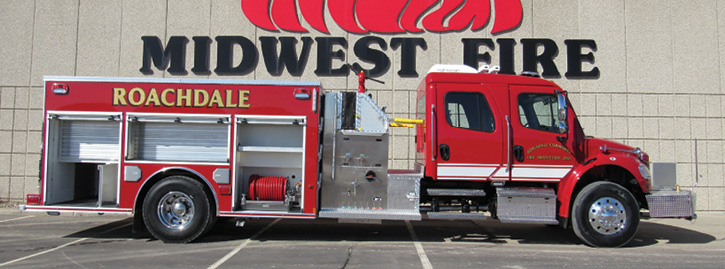
5 A pumper with a top-mount pump operator’s panel and a four-door commercial chassis.

6 This brush truck was manufactured with an all-aluminum treadplate body. Midwest also offers brush trucks with its All-Poly body.

7 This line-up in front of Midwest’s factory shows another variation of a brush truck with a treadplate body, a small rescue truck, and a large-capacity tanker-pumper on a two-door commercial chassis with a tandem rear axle.
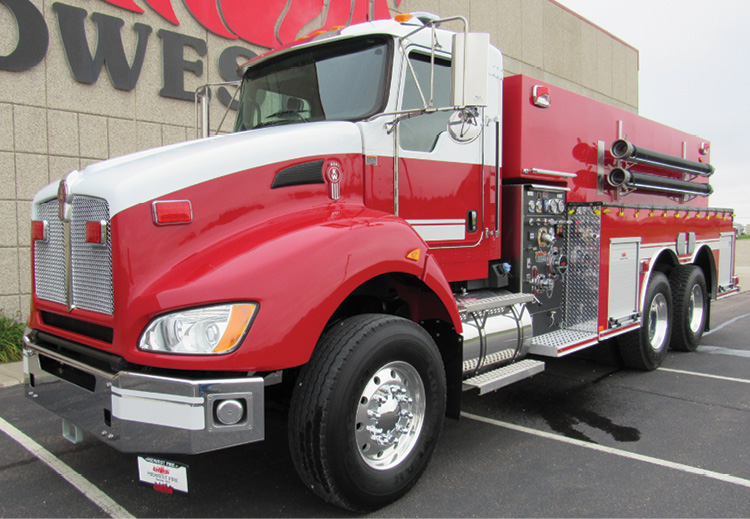
8 This two-door Kenworth tandem-chassis tanker-pumper has the forward portion of the tank notched over the pump module.
WARRANTY
Atchison comments on how the company handles repairs without a dealer network. “Providing warranty service after a sale is a subject that we anticipate and discuss a lot,” she says. “Over the last 30 years, we have delivered more than 1,000 fire trucks to departments throughout North America and honestly, warranty service after the sale is NOT an issue that has been a problem area for our company—ever. We work hand in hand with fire departments and their local service providers whenever necessary.”
She continues, “The component part vendors with whom we choose to work are committed to taking care of the customers we share. If a vendor does not do this, we would quickly fire them and find another supplier. Midwest’s warranty expense has consistently been low. It is less than 0.50 percent of sales annually, which is a testament to the quality of the trucks we manufacture.
“To the extent a department has a warranty concern, they contact us, and our team works directly with them to solve problems and/or arrange for repairs. It has NOT been a challenge to us in terms of getting our apparatus serviced across the wide geography of North America. As a general rule, most fire departments have a local service center with which they like to work. Generally, we are able to coordinate with their preferred service center to perform warranty work on their trucks.”
Atchison points to a document that expresses Midwest’s position on warranties. “The following document prepared by Brett Jensen does a great job of summarizing our position. We include it with every proposal or bid.
SERVICE AFTER THE SALE BY BRETT JENSEN
“One of the most important decision-making factors when making a critical purchasing decision for a new fire apparatus is the quality and guarantee of service after the sale has been made. It’s one of the most frequently asked questions we receive: ‘What type of support do you offer if we have issues with the truck down the road?’ My name is Brett Jensen and, as VP general manager at Midwest Fire, I can guarantee our service is second to none.
“We are committed to the quality of our workmanship. Should any problems arise with your apparatus, I will personally be your point of contact to resolve it. We begin with assessing the issue and then, depending on the nature of it, connecting you with our in-house technicians for troubleshooting. If we determine your equipment needs to be repaired in any way, I will make contact on your behalf with qualified and trusted service centers near you, so that you can keep doing your job.
“Does your department already have a local center for apparatus maintenance? If so, we will work with them to resolve any issues that might arise. You know your town best, and we trust your preferences and contacts. If we discover that the issue can be resolved by a part covered by a manufacturer’s warranty, I will contact the manufacturer and arrange for a replacement for your department. In addition, we cover the costs for any labor or parts required. The only thing we ask of our customers is to coordinate the time for the equipment to be repaired.
“For the first year after the initial purchase, Midwest Fire offers a bumper-to-bumper warranty on your apparatus. If a manufacturer we use doesn’t offer a warranty for their part, we will carry our own warranty should it need repair. Beyond that first year, the pump, LEDs, electric, plumbing, paint, workmanship, and tank body all carry warranties ranging from five years to lifetime depending on the part.
“When it comes to purchasing new equipment for your department, service after the fact is just as important as acquiring the apparatus itself. Our goal is to resolve any issue as fast and hassle-free as possible for our customers. If you have any questions regarding our apparatus or service offerings, please contact us.”
Without the benefit or need of a dealer network, total nationwide sales have increased substantially since the Atchisons purchased Midwest. This has been accomplished with virtually the same number of employees all the while maintaining the warranty expense of one half of one percent of total sales. Sarah Atchison seems to be running a tight ship.
BILL ADAMS is a member of the Fire Apparatus & Emergency Equipment Editorial Advisory Board, a former fire apparatus salesman, and a past chief of the East Rochester (NY) Fire Department. He has 50 years of experience in the volunteer fire service.

